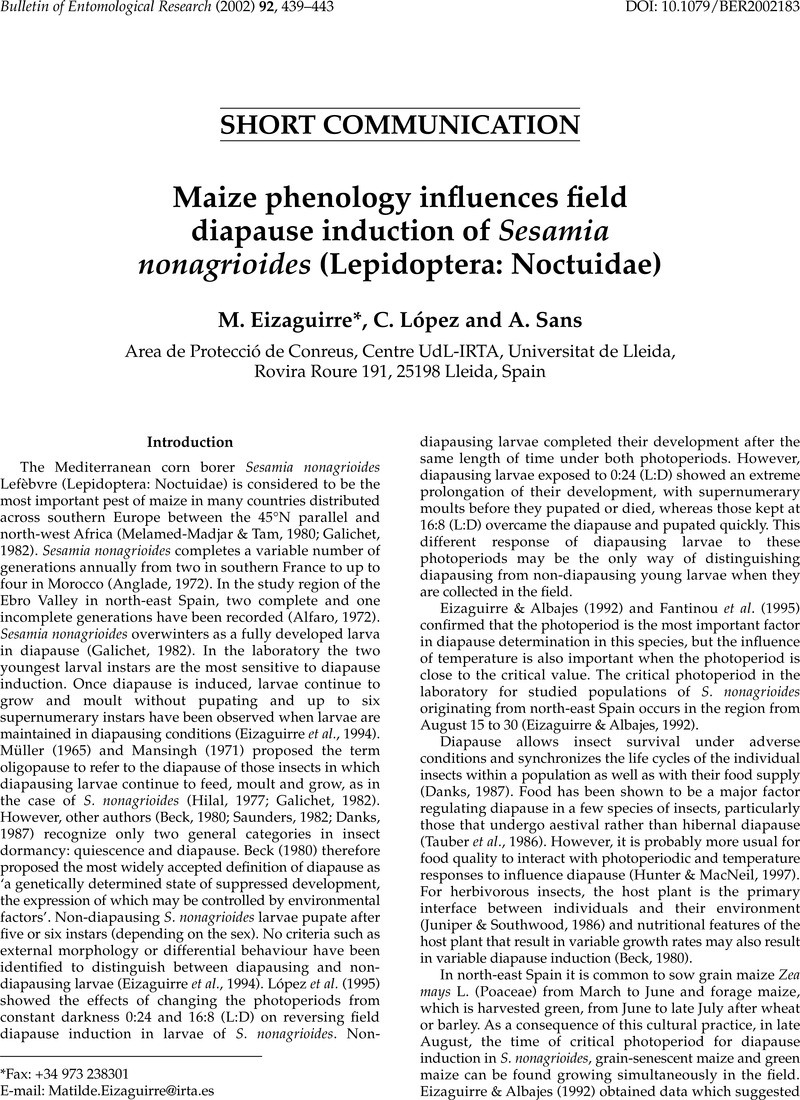Crossref Citations
This article has been cited by the following publications. This list is generated based on data provided by Crossref.
Eizaguirre, M.
López, C.
and
Albajes, R.
2004.
Dispersal capacity in the Mediterranean corn borer, Sesamia nonagrioides.
Entomologia Experimentalis et Applicata,
Vol. 113,
Issue. 1,
p.
25.
Eizaguirre, Matilde
Schafellner, Christa
López, Carmen
and
Sehnal, Frantis˘ek
2005.
Relationship between an increase of juvenile hormone titer in early instars and the induction of diapause in fully grown larvae of Sesamia nonagrioides.
Journal of Insect Physiology,
Vol. 51,
Issue. 10,
p.
1127.
Eizaguirre, Matilde
Albajes, Ramon
López, Carmen
Eras, Jordi
Lumbierres, Belén
and
Pons, Xavier
2006.
Six Years after the Commercial Introduction of Bt Maize in Spain: Field Evaluation, Impact and Future Prospects.
Transgenic Research,
Vol. 15,
Issue. 1,
p.
1.
Bayram, Ahmet
Gültekin, Ahmet
Bruce, Toby J.
and
Gezan, Salvador
2007.
Factors associated with mortality of the overwintering generation ofSesamia nonagrioides under field conditions.
Phytoparasitica,
Vol. 35,
Issue. 5,
p.
490.
Pérez-Hedo, Meritxell
Albajes, Ramon
and
Eizaguirre, Matilde
2011.
Modification of Hormonal Balance in Larvae of the Corn Borer Sesamia nonagrioides (Lepidoptera: Noctuidae) Due to Sublethal Bacillus thuringiensis Protein Ingestion.
Journal of Economic Entomology,
Vol. 104,
Issue. 3,
p.
853.
Vilaró, Francisca
Pérez-Hedo, Meritxell
Eras, Jordi
Canela, Ramon
and
Eizaguirre, Matilde
2012.
UHPLC–MS Analysis of Juvenile Hormone II in Mediterranean Corn Borer (Sesamia nonagrioides) Hemolymph Using Various Ionization Techniques.
Journal of Agricultural and Food Chemistry,
Vol. 60,
Issue. 12,
p.
3020.
Pérez-Hedo, Meritxell
Sánchez-López, Isabel
and
Eizaguirre, Matilde
2012.
Comparative analysis of hemolymph proteome maps in diapausing and non-diapausing larvae of Sesamia nonagrioides.
Proteome Science,
Vol. 10,
Issue. 1,
Maiorano, Andrea
Cerrani, Iacopo
Fumagalli, Davide
and
Donatelli, Marcello
2014.
New biological model to manage the impact of climate warming on maize corn borers.
Agronomy for Sustainable Development,
Vol. 34,
Issue. 3,
p.
609.
Catarino, Rui
Ceddia, Graziano
Areal, Francisco
Parisey, Nicolas
and
Park, Julian
2016.
Managing maize under pest species competition: Is Bt (Bacillus thuringiensis) maize the solution?.
Ecosphere,
Vol. 7,
Issue. 6,
Farinós, Gema P
Hernández‐Crespo, Pedro
Ortego, Félix
and
Castañera, Pedro
2018.
Monitoring of Sesamia nonagrioides resistance to MON 810 maize in the European Union: lessons from a long‐term harmonized plan.
Pest Management Science,
Vol. 74,
Issue. 3,
p.
557.
Piovesan, M.
Carneiro, E.
Specht, A.
and
Casagrande, M.M.
2019.
Where and when? How phenological patterns of armyworm moths (Lepidoptera: Noctuidae) change along a latitudinal gradient in Brazil.
Bulletin of Entomological Research,
Vol. 109,
Issue. 4,
p.
490.
Horgan, Finbarr G.
2020.
Crop Protection Under Changing Climate.
p.
101.
García, Matías
García-Benítez, Carlos
Ortego, Félix
Farinós, Gema P
and
Wu, Yidong
2023.
Monitoring Insect Resistance to Bt Maize in the European Union: Update, Challenges, and Future Prospects.
Journal of Economic Entomology,
Vol. 116,
Issue. 2,
p.
275.



